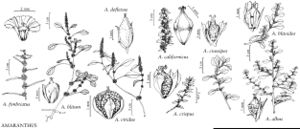Difference between revisions of "Amaranthus crassipes"
Linnaea 6: 757. 1831.
imported>Volume Importer |
imported>Volume Importer |
||
| Line 59: | Line 59: | ||
|publication year=1831 | |publication year=1831 | ||
|special status=Illustrated | |special status=Illustrated | ||
| − | |source xml=https:// | + | |source xml=https://bitbucket.org/aafc-mbb/fna-data-curation/src/2e0870ddd59836b60bcf96646a41e87ea5a5943a/coarse_grained_fna_xml/V4/V4_846.xml |
|genus=Amaranthus | |genus=Amaranthus | ||
|subgenus=Amaranthus subg. Albersia | |subgenus=Amaranthus subg. Albersia | ||
Latest revision as of 22:01, 5 November 2020
Plants annual, glabrous. Stems prostrate or weakly ascending, erect when young, branched mostly from base, 0.1–0.6 m. Leaves: petiole nearly 1/2 as long as blade; blade broadly elliptic, obovate, orbiculate, or oblanceolate, (0.5–)1–3(–4.5) × 0.3–2(–2.5) cm, base cuneate, margins entire, plane to undulate, apex broadly rounded or emarginate. Inflorescences axillary clusters borne from base to apex, axes much thickened, appearing inflated, becoming indurate at maturity (only in A. scleropoides and A. crassipes). Bracts of pistillate flowers keeled (only A. scleropoides and A. crassipes have keeled bracts), deltate, 0.5–0.9 mm. Pistillate flowers: tepals (4–)5, narrowly spatulate, clawed, with small expanded blade, equal or subequal, 2–3 mm, apex rounded and apiculate; claws becoming indurate and scarious at maturity; style branches spreading; stigmas usually 2(–3), almost sessile. Staminate flowers intermixed with pistillate; tepals 5, membranaceous; stamens 3(–5). Utricles obovoid to compressed-obovoid, 1.4–2 mm, shorter than tepals, prominently muricate (especially in distal 1/2), indehiscent. Seeds dark brownish or reddish black to black, compressed-ovoid to broadly lenticular, 1–1.4 mm diam., shiny.
Phenology: Flowering summer and fall.
Habitat: Open, seasonally wet flats, shores of water bodies, waste places, other disturbed habitats
Elevation: 0-1300 m
Distribution
Ala., Ariz., Fla., La., N.Mex., S.C., Tex., ne Mexico, West Indies, n South America, occasionally introduced in other regions.
Discussion
Two varieties have been distinguished by J. Henrickson (1999) within Amaranthus crassipes: var. crassipes with leaf blades nearly orbiculate to ovate (obovate) and conspicuous veins on the green to yellow-green abaxial leaf surface; and var. warnockii (I. M. Johnston) Henrickson (= A. warnockii I. M. Johnston) with narrower oblanceolate grayish leaves with less distinct venation on the abaxial leaf surfaces. In Henrickson’s treatment, var. crassipes occurs mostly in the coastal areas (and is also reported for Arizona), while var. warnockii is reported from inland southwestern Texas and the Chihuahuan Desert region (Mexico: Coahuila, Chihuahua). We have not seen material of the new varieties and cannot evaluate their validity.
Selected References
None.
